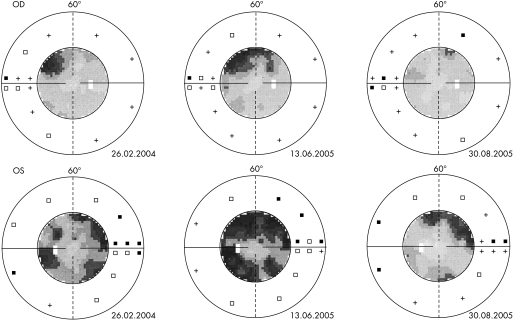The relationship between the head‐down body position and increased IOP is well known.1,2,3,4,5,6 We present a 46‐year old woman who presented with a worsening of glaucomatous visual field defects one year after starting to perform regularly a particular postural headstand yoga exercise, reversible after cessation of the exercise.
In 10 non‐yoga‐practising volunteers intraocular pressure (IOP) was measured by Tono‐Pen in sitting and immediately after assuming a headstand position. A more than twofold increase of the IOP was measured in the headstand position. Therefore postural (head‐down) yoga exercises are clearly not recommended for patients suffering from glaucoma.
Case report
A 46‐year‐old Caucasian woman followed at our clinic for a bilateral juvenile open‐angle glaucoma presented on a routine examination a significant worsening of her visual field defects on both eyes (fig 1). Twenty years previously a bilateral trabeculectomy had been performed and since then intraocular pressures had always been stable without treatment (between 14 and 16 mm Hg). Slit‐lamp examination revealed no apparent reason for the visual field deterioration. Detailed history taking finally showed that she had started one year previously (shortly after the last visual field examination) regularly to practise yoga, particularly a headstand position, called “sirsasana”. Measurement of the IOP by Tono‐Pen in the headstand position showed a twofold increase of IOP compared to IOP in the sitting position (32 compared to 16 mm Hg). We asked the patient to stop any yoga exercise with the head‐down position and some months later the visual field defects improved significantly.
Figure 1 Visual field some months before and one year after starting postural yoga and one year after stopping it.
Comment
Postural yoga (“asanas”), including headstand posture (“sirsasana”), is along with breathing exercises (“pranayama”) and meditation (“dhyana”) one of the three basic components of hatha yoga, the system on which much of western yoga is based. Yoga has become a popular practice in the western world. In 1998 an estimated 15 million American adults had used yoga at least once in their lifetime, 7.4 million during the previous year.7 Sirsasana is a preferred position that seems to induce euphoria and comfort after performing the posture.6
To evaluate the increase of IOP due to headstand position we measured IOP in 10 non‐yoga‐practising volunteers (4 women and 6 men, mean age 37.3 ± 11.3 years) in a sitting position and immediately after assuming a headstand position. IOP was measured by a single examiner using the Tono‐Pen XL (Medtronic Solan, Jacksonville, Florida) in the left eye after application of oxybuprocaine 0.4% eye drops. IOP was measured four times consecutively and the mean IOP was calculated. All volunteers were in good health and did not present any known ocular pathology. The mean sitting IOP was 13.9 ± 1.76 mm Hg (range: 10.75–18.5). Immediately after assuming a headstand position the mean IOP increased to 31.8 ± 4.22 mm Hg (range: 23–38.75). These findings agree with a recent study (including 75 experienced yoga practitioners) that recorded a uniform twofold increase in the IOP during sirsasana, which was maintained during the posture and returned to near baseline level immediately after resuming a sitting posture.6 Increased IOP has been explained with raised episcleral venous pressure1 or increased choroidal volume by vascular engorgement.8,9
This case shows once more the importance of a good history taking and how sometimes unexpected personal habits can influence ophthalmologic pathologies. Patients suffering from glaucoma should be advised against practising postural (head‐down) yoga exercises.
Footnotes
Competing interests: None.
References
- 1.Krieglstein G K, Waller W K, Leydhecker W. The vascular basis of the positional influence of the intraocular pressure. Albrecht Von Graefes Arch Klin Exp Ophthalmol 197820699–106. [DOI] [PubMed] [Google Scholar]
- 2.Kaskel D, Muller‐Breitenkamp R, Wilmans I.et al [The influence of changes in body position on intraocular pressure, episcleral venous pressure, and blood pressure (author's transl)]. Albrecht Von Graefes Arch Klin Exp Ophthalmol 1978208217–228. [DOI] [PubMed] [Google Scholar]
- 3.Chiquet C, Custaud M A, Le Traon A P.et al Changes in intraocular pressure during prolonged (7‐day) head‐down tilt bedrest. J Glaucoma 200312204–208. [DOI] [PubMed] [Google Scholar]
- 4.Linder B J, Trick G L. Simulation of spaceflight with whole‐body head‐down tilt: influence on intraocular pressure and retinocortical processing. Aviat Space Environ Med 198758A139–A142. [PubMed] [Google Scholar]
- 5.Linder B J, Trick G L, Wolf M L. Altering body position affects intraocular pressure and visual function. Invest Ophthalmol Vis Sci 1988291492–1497. [PubMed] [Google Scholar]
- 6.Baskaran M, Raman K, Ramani K K.et al Intraocular pressure changes and ocular biometry during Sirsasana (headstand posture) in yoga practitioners. Ophthalmology 20061131327–1332. [DOI] [PubMed] [Google Scholar]
- 7.Saper R B, Eisenberg D M, Davis R B.et al Prevalence and patterns of adult yoga use in the United States: results of a national survey. Altern Ther Health Med 20041044–49. [PubMed] [Google Scholar]
- 8.Rosen D A, Johnston V C. Ocular pressure patterns in the Valsalva maneuver. Arch Ophthalmol 195962810–816. [DOI] [PubMed] [Google Scholar]
- 9.Schuman J S, Massicotte E C, Connolly S.et al Increased intraocular pressure and visual field defects in high resistance wind instrument players. Ophthalmology 2000107127–133. [DOI] [PubMed] [Google Scholar]



